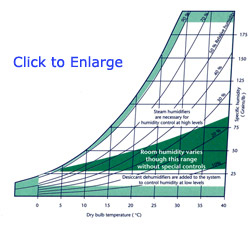Humidity
 Unless
the architect specifies otherwise, the humidity in an environmental room
will vary over the course of the year as ambient moisture levels change.
At any one time, the room humidity will be reasonable constant, b
Unless
the architect specifies otherwise, the humidity in an environmental room
will vary over the course of the year as ambient moisture levels change.
At any one time, the room humidity will be reasonable constant, b
ut the seasonal variation will range from 60 to 90% relative humidity in rooms held below 10ºC and between 10% and 30% in warm rooms.
Cold storage rooms will have much wider swings in relative humidity because the mechanical systems are not designed for close temperature control. Relative humidity is a function of both absolute humidity and temperature. Seasonal variations in absolute humidity combine with swings in temperature to shift the relative humidity value much more widely in cold storage rooms than in environmental rooms, where the temperature variable is closely controlled.
When the end user needs tighter control of humidity, the room manufacturer must add equipment to either remove or add moisture, counteracting the natural seasonal variations and the effect of products or processes present in the room itself.
In low-temperature rooms, dehumidification equipment will be necessary. High temperature rooms will need humidification equipment to maintain control. If the temperature is near comfort conditions, both humidification and dehumidification equipment will be required to maintain a constant humidity level throughout the year.
Low-range humidity control is accomplished with desiccant dehumidifiers. These remove moisture from air as a vapor, rather than by cooling and condensation. Cooling equipment is not suitable in most circumstances because the air is so cold that condensate freezes. The frozen condensate blocks airflow through the coil. Interrupting the airflow creates large fluctuations in temperature and relative humidity in the room.
Humidifiers are available in several configurations, but environmental rooms should be supplied with steam boilers, which generate vapor to be distributed evenly throughout the room. Since the vapor is warm, it contains enough energy for complete evaporation without removing heat from the air--so the room temperature remains quite stable.
Other types of humidifiers can be made suitable, but can create difficulties unless special precautions are taken. Ultrasonic units can produce airborne dust particles as droplets evaporate. Evaporative pad units have a water reservoir which must be cleaned regularly to avoid microbial growth. Both pad and ultrasonic units remove heat from the air to evaporate the water, so they make it more difficult to maintain close temperature control.
Dehumidifiers and associated controls add about 25% to the cost of the room. Humidifiers add about 15%.
When the end user needs humidity control, the architect should specify a maximum annual humidity variation of either ±5% relative humidity or ±2%. At 2%, the equipment does not change but measurement and control equipment is different. Specifying ±2% adds roughly 10 percent to the cost of the humidity controlled room.
The simplified psychrometric chart shows the range of control available in
environmental rooms. If the end user needs control outside of this range,
or must control humidity
closer than ±2% rh, the architect should contact the room manufacturer.
Additional variable begin to strongly effect the room cost, and each case needs
detailed discussion.
| Environmental
Rooms | Dry
Rooms | Clean
Rooms | Archival
Storage Vaults | |
Harris Environmental Systems, Inc. • 11 Connector Road • Andover, MA 01810 |
| tel: (978) 470-8600 • fax: (978) 475-7903 |